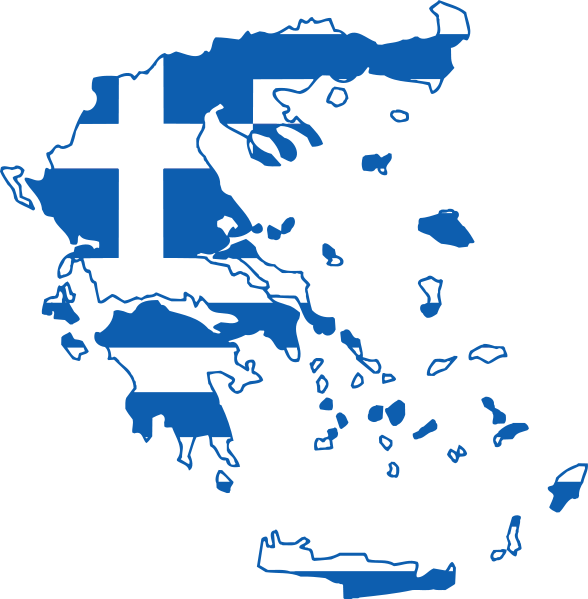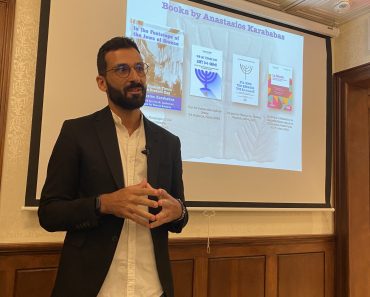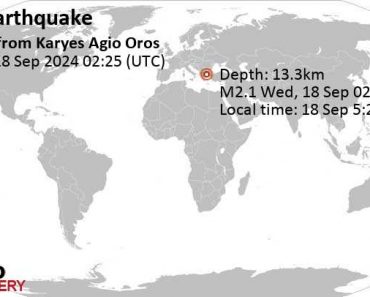Recently I made the journey across the Mani region of the Peloponnese to visit again the lovely coastal towns of Kardamyli and Trahila. I did so at the invitation of my good friends and local community leaders, the current West Mani Mayor Giorgos Chioureas and the former Mayor Dimitrios Giannamaras, to discuss plans for major Greek campaign commemorative activities in April next year. I thank Melbourne’s Peter Patistseas OAM for facilitating my visit.
Every time I travel along the coastline south-east of Kalamata I am taken back to the accounts of the hundreds of Allied soldiers who travelled this way in late April 1941. They did so following the battle of Kalamata waterfront and the looming fall of the city to the advancing Germans. Many left in advance of the German arrival, while others joined their comrades after escaping the temporary prisoner enclosures established by the Germans. Some were lucky to make some of their way in trucks but soon the poor roads in the area ended and they had to join others in the long and arduous journey on foot. Forced to travel by night to avoid enemy air attack, they made their way south in the hope of evacuation to Allied lines on Crete or in the Middle East.

Along the way these brave but desperate men hid in the caves that still dot the mountain sides along the coast. Soon they would gather in a number of local villages – Trahila, Selinitsis and Limeni are all mentioned in the records – where they were helped by the locals, hiding and supplying them, despite the warnings of retribution by the advancing Germans. On the night of April 30-May 1 some 235 Allied soldiers were successfully evacuated by three British Royal Navy warships. This was the last major evacuation of the campaign from the Greek mainland.
I have read many of the accounts by these Allied soldiers and met with the families of two of them – those of Private Syd Grant and Captain Robert Vial, both from Victoria. While Syd took photographs of his time at Trahila, Robert wrote an account of his time there in his post-war memoir. Many of these accounts talked of the generosity and support of the locals, including that of Australian Captain Philip Woodhill who was with Robert. These compelled me to visit the ground that soldiers like Syd and Robert walked in 1941 and to visit the villages where they were aided. In 2022 I was able to locate the ruined Agia Paraskevi Church where Syd was hidden and which he photographed for posterity.

This experience compelled me to work to create a memorial to these escapes and the brave local people who helped them. Based on my research, I wrote the text and organised the production of a commemorative plaque to the Mani evacuations, Melbourne’s Pammessinian Brotherhood Papaflessas joining me in supporting the creation of the plaque. Two years ago the plaque was delivered to Greece and now it is in the hands of the President of the Trahila community.
I believe that Trahila is the most appropriate location for this important new memorial. It symbolises all the villages where the Allied soldiers were aided and it is easily accessible from nearby Kardamyli. Most importantly, not only did 100 Allied soldiers gather here but it is the village that Syd was able to capture in his evocative photographs of his short time there awaiting evacuation. Here he photographed two village women bringing food to the soldiers and it was on the harbour that he photographed one of the boys of the village.

The experience of these soldiers and their hosts connects communities and people in Australia and Greece. Even in my own home town of Melbourne’s Oakleigh a local man – Private George Foot – was one of those who walked these village streets, was looked after by the locals and was saved from capture by evacuation.
So you can imagine my joy at meeting Giorgos and Dimitrios by the waters of the bay at Kardamyli to discuss plans on how we can commemorate these important evacuations. Over a lovely meal Giorgos revealed his enthusiasm and that of the West Mani municipality for honouring the Allied soldiers and their local helpers. He explained that the community was keen for the commemorative plaque to be installed at Trahila.
The next day Giorgos took me and Dimitrios to Trahila, driving along the coast road on the route that would have been followed by Syd, Robert and George in 1941. When we arrived we were welcomed by the village President and many of its residents in its lovely little plateia with the harbour beyond. There the locals had proudly displayed our plaque, awaiting its installation.

We were given such a warm welcome, with traditional village hospitality, local foods on offer and real generosity of spirit. It was clear to me that the locals held the story of their village and its help for the Allied soldiers to heart. I gave an impromptu address, thanking the President and the community for their welcome and telling the story of the evacuations, the creation of the plaque and how much it meant to the veterans families back in Australia. They were particularly taken by the story of how the Australian soldiers were asked to sing “Waltzing Matilda” before they were allowed to board the warships out in the bay! Soon one of the villagers had found the song on her mobile and the plateia resounded to this old Australian ballad!
What followed is truly amazing. As we sat and talked to the locals, people came forward with local accounts of the days that the Allied soldiers arrived in the village. One man revealed that the two women who were photographed by Syd bringing food to the Agia Paraskevi Church were his relatives. I was able to capture some of these accounts on video but obviously there are many more to be recorded for posterity. I urged the villagers to record their recollections and those of their families. These are important connections between Australia and Greece that need to be preserved and shared between our communities.

Next the West Mani Mayor organised a private tour of the former home of Patrick and Joan Leigh Fermor close to the southern edge of Kardamyli, situated on a piece of land that stretches down to the beautiful bay below. The house was built by Patrick and his wife Joan, combining local stone and wood, designed to reflect Patrick’s philhellenic personality and Joan’s photographic sensibilities. It houses his extensive library, all surrounded by beautiful fragrant gardens and outdoor spaces with amazing views of the bay. Following Patrick’s death, the home is now part of the Benaki Museums. Newly restored, their former home is not so much a museum as a literary and cultural space, with educational and literary functions to encourage writers and academics. The home has been re-born as an enabler to new literary endeavours – as Patrick and Joan would’ve wished.
The Benaki’s local manager Ms Myrto Kaouki who guided us through the home and gardens, explaining its history and development also expressed interest in it possibly playing a part in the local Greek campaign commemorations being planned for next year. She also expressed a desire for my publications on the Hellenic link to Anzac to be part of the Benaki Museum Library.
As a result of this visit and the discussions with Giorgos, the people of Trahila and Ms Kaouki we have now advanced plans for major commemorative events to be held in Kardamyli and Trahila around the anniversary of the evacuations from Trahila on the night of April 30-May 1 in 1941. Discussions covered the installation of the plaque at the plateia in Trahila, with a commemorative service followed by a celebration. These might include speeches and presentations, with the possibility of a pictorial display (like that I have produced for the Imbros and Gallipoli story). A musical performance including a rendition of the evacuation song “Waltzing Matilda” was also proposed.

We also discussed the possibility of installing a complementary commemorative plaque in Kardamyli, focusing on the role of the town and the whole region in the final days of the Greek campaign on the mainland. The proposed pictorial display may also be permanently housed in the town. Giorgos expressed interest in hosting a community screening of the new documentary Anzac The Greek Chapter as part of the commemorations, given that Trahila and Syd Grant’s photographs features in this story of the Anzacs in Greece in 1941. The Leigh Fermor home is also a possibility for involvement in the commemorations, possibility hosting a reception and presentation.
The West Mani Municipality were most interested in the possibility that the proposed commemorative events might be attended by the Australian Ambassador, a number of Victorian politicians led by Lee Tarlamis OAM MP and representatives of the veteran’s families. We discussed how many more diplomatic, government, military and community representatives may also attend along with numerous interested individuals. The timing of the proposed annual even in the days following the traditional Anzac Day service in Athens would encourage its being a permanent fixture in Greece’s commemorative calendar.
Giorgos and Dimitrios pointed out that West Mani is proud of its history and culture, having created numerous tourism aids for visitors as well as major memorials and cultural events, such as the famous Kardamyli Festival. The proposed annual Mani Evacuations commemorations in April would complement this approach. I look forward to working with the West Mani Municipality to realise these proposals for the descendants of both the veterans and their local helpers.
*Jim Claven OAM is a trained historian, freelance writer and published author who has researched the Anzac trail in Greece across both world wars. He is the author of Grecian Adventure which recounts some of the Anzac history of the 1941 Greek campaign and was recently the Associate Producer of the new documentary Anzac The Greek Chapter on the Greek campaign. He has worked to have a series of plaques erected across Greece commemorating locations connected with the 1941 campaign. He thanks Peter Patisteas OAM for assisting in the organisation of his visit to Mani. He can be contacted via email – jimclaven@yahoo.com.au.







